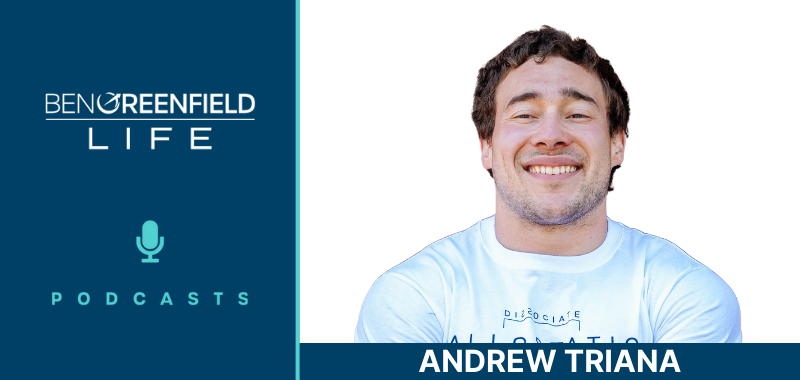August 21, 2017
Click here for the full written transcript of this podcast episode.
I recently took a test that uses machine learning to predict biochemical test results (like blood, urine and stool) – a test called the “Elite Performance Analysis (EPA) tool“.
Over the last three years, the folks at Nourish Balance Thrive (Dr. Tommy Wood and Chris Kelly, both former podcast guests) who designed this test have worked with over 1,000 athletes, averaging over 100 biochemical markers collected per athlete, including:
-Blood biochemistry
-Urine tests (DUTCH and organic acids)
-Stool tests (PCR and culture)
-Subjective quality of life questions (a Health Assessment Questionnaire, or HAQ), scored on an analog scale (1-5)
As well as working to optimize the performance of athletes at every level, another goal of Nourish Balance Thrive is to give more people access to the type of work they do by increasing speed of access and reducing cost. Machine learning provides for a very good way to do this. By training an algorithm based on historical HAQ and biochemical test data, they can predict five common patterns of performance killers that they regularly see in their clients, including:
1. Blood sugar dysregulation (high/low fasting blood sugar and HbA1c, or high fasting insulin)
2. Low sex hormones (testosterone in men and oestrogen in women)
3. Suboptimal hemoglobin (“low oxygen deliverability” <14.5 g/dl in men and <13 in women)
4. Gut dysbiosis (including clostridial and yeast overgrowths, parasites, and H. pylori)
5. Circadian/HPA axis dysregulation (total/free cortisol outside of the normal pattern during the day)
Dr. Tommy Wood, who I interview on today's show, is a Senior Fellow at the University of Washington, and Chief Medical Officer of Nourish Balance Thrive, an online-based company using advanced biochemical testing to optimize performance in athletes. Close to 1,000 athletes have been through the Nourish Balance Thrive coaching program, from weekend warriors to Olympians and world champions, with hundreds of performance biomarkers available for each client. Based on their accumulated data, the team is using machine learning algorithms to rapidly and reliably predict common problems in athletes including low hemoglobin, low sex hormones, and gut dysbiosis.
Tommy has a bachelor's degree in biochemistry from the University of Cambridge, a medical degree from the University of Oxford, and a PhD in physiology and neuroscience from the University of Oslo. He is President-elect of Physicians for Ancestral Health, and is on the scientific advisory board of Hintsa Performance. Alongside his career in medicine and research, Tommy has published and spoken on multiple topics surrounding functional and ancestral approaches to health, including examining the root causes of multiple sclerosis (paper, talk for the public, talk for physicians) and insulin resistance (published article). Tommy has also coached and competed in multiple sports including rowing, CrossFit, powerlifting, and ultra-endurance racing.
During our discussion, you'll discover:
-How a “machine algorithm” can predict gut dysbiosis issues such as yeast overgrowth and a urine organic acids test…[7:30]
-The surprising fixes for low testosterone and hormonal imbalances in both men and women…[21:30]
-Why Tommy is such a fan of chopping wood…[22:44]
-The three powerful nutrients that can lower your blood glucose…[29:30]
-How personal relationships and friends can affect your HPA axis and cortisol…[30:05]
-Tommy's morning routine, including the one superfood he swears by…[35:30 & 38:25]
-How Tommy uses blood flow restriction training…[39:51]
-What Tommy's spiritual practice consists of…[42:30]
-And much more!
Resources from this episode:
-Elite Performance Analysis (EPA) tool
-Elite Performance Program (click here to join, and you'll automatically get free tickets to the “Who Wants To Live Forever” Sep 8-11 Iceland conference and a free in-person consultation with Tommy in Iceland!)
-My original podcast with Tommy – The Underground Test That Shows You How To Legally Upgrade Your EPO, Increase Your Oxygen Levels, Boost Your Red Blood Cells & Build Double-Digit Percentages In Power And Endurance.
-Podcast: What Is An Organic Acids Test?
-Podcast: Dr. Cowan's vegetable powder
-September 8-11, 2017: “Who Wants To Live Forever?” conference in Reykjavik, Iceland. Most of us not only want to have a long lifespan, but also a long health span; to be fit and healthy throughout the course of our lives. As we move into this unprecedented era of human history, a question arises: how far can the human health span be extended, and what are the most effective ways to achieve longevity? Join me and other health experts as we dive deep into this subject in the country with strongest and healthiest humans on the planet! Click here to register.*
*There is a Cycle Workshop as part of the “Who Wants To Forever” conference: In this workshop you’ll cycle in and around the Reykjavik area with one of the most influential people in health and fitness (ME!), gaining direct access to my wealth of knowledge on how to optimize your performance. Among the things you will learn along the ride are: Breathing techniques to enhance your longevity and health. Modern and ancient techniques to harness the natural magnetic fields of the planet we live on. How to use heat and hypoxia to increase blood flow and maximize your response to training. Basic techniques for cold thermogenesis, how to use both cold and warm water exposure effectively. And much, much more! Sign up now – we’re sure you don’t want to miss this! Click here for the bike event only.
Podcast Sponsor:
-BioTropic Labs – Go to BengreenFieldFitness.com/biotropiclabs and use code “benpod10” to save 10 per cent PLUS enter to win 1 of 5 awesome prize packs now! Winner will be announced August 29 on our Facebook page.
But the podcast ain't all…
…in addition to the podcast, Tommy, Chris and Megan Roberts MSc of Nourish Balance Thrive put together this comprehensive article all about the top five performance killers and the Nourish Balance Thrive (NBT) 7-Minute Elite Performance Analysis Tool.
What’s Killing Your Performance? Find Out In 7 Minutes!
By Megan Roberts MSc, Christopher Kelly BSc, and Tommy Wood MD PhD
from Nourish Balance Thrive
As an athlete, you’re always looking for the next way to gain that competitive edge. However, the journey to optimal health and peak performance can also be challenging and complex. For instance, despite doing everything “right”, perhaps you’ve found that:
- Your top-end intensity just isn’t accessible during your training.
- Your sleep isn’t restorative.
- You suffer from regular gas and bloating.
- You’re holding a few extra pounds around the middle.
- You get that 3pm slump like clockwork.
- Your drive is tanked.
If you’re struggling with any of the above, we have good news! In just 7 minutes you can dramatically accelerate your journey to optimal performance. This is the power of the Nourish Balance Thrive (NBT) 7-Minute Elite Performance Analysis Tool.
Over the last three years, NBT has worked with over 1,000 athletes, averaging over 100 biochemical markers per athlete, including:
- Blood biochemistry
- Urine tests (DUTCH and organic acids)
- Stool tests (PCR and culture)
- Subjective quality of life questions (a Health Assessment Questionnaire, or HAQ), scored on an analog scale (1-5)
In this article, you will discover how we have used this data, in conjunction with a machine learning algorithm, to determine the five most common performance killers our athletes are experiencing. Then we’ll show you how we used the analysis to create a 7-minute questionnaire that can help you determine what’s killing your performance on race day, in the bedroom, at work, or at home.
The “Big 5” Performance Killers
As well as working to optimize the performance of athletes at every level, another goal of NBT is to give more people access to the type of work we do, and increase the speed with which people can start addressing their health and performance in a personalised and targeted manner. Machine learning provides the best way to do this. By training an algorithm based on historical HAQ and biochemical test data, we can now accurately predict the five most common patterns of performance killers that we regularly see in our athletes:
- Low sex hormones
- Gut dysbiosis
- Blood sugar dysregulation
- Circadian dysregulation (and HPA axis dysfunction)
- Low oxygen deliverability (suboptimal hemoglobin)
In this article we will discuss how each of the above can wreak havoc on your physiology, and some of the tools we use at NBT to re-establish optimal health and peak performance in our athletes.
Low Sex Hormones
What is it and how does it happen?
Overtraining as well as under-fueling can wreak havoc on hormones. Low testosterone in men and oestradiol in women have both been associated with the negative energy availability often seen in overtrained athletes [1,2]. Endurance exercise seems to be particularly taxing on the reproductive hormones [3]. It has also been shown that free testosterone decreases (and cortisol increases) [4] following exhaustive exercise, which may increase the risk of a potential hormone imbalance in somebody that isn’t training or recovering sensibly.
Why should I care?
Healthy levels of sex hormones are essential if you want to be able to go harder and faster (in more ways than one).Testosterone is an anabolic hormone that promotes healthy sex drive and reproductive function in both men and women. Low testosterone in male athletes has been associated with weaker bones, decreased exercise performance, increased risk for cardiovascular disease, and fertility problems including erectile dysfunction [1].
In women, healthy estrogen levels are associated with proper cognition and a decreased risk for cardiovascular and Alzheimer’s disease. Low estrogen is associated with osteoporosis, irregular periods, low drive, stress fractures, decreased exercise performance, and potentially an increased risk of cardiovascular disease [5].
In contrast to testosterone and estrogen, the stress hormone cortisol is catabolic (i.e. it breaks things down, like muscle tissue). During times of stress, such as intense exercise, the body intelligently doesn’t want to waste precious resources on long-term building projects such as digesting food, building muscle, reproduction, or immunity. As a result, cortisol rises during exercise and increases fatty acid mobilization and blood glucose for the working muscles and brain. However, some evidence suggests that the increase in cortisol in the post-exercise window is actually anabolic (i.e. it helps build muscle) [6]. This may even account for the observation that women get similar post-exercise muscle protein synthesis compared to men despite lower testosterone levels [7]. The kicker is that the acute cortisol response should be followed by a natural decrease back to baseline once balance is restored. However, our constantly stress-filled lives often cause cortisol to become dysregulated. It’s important to recognize that cortisol isn’t inherently bad, but too much (or even too little) can cause an undesirable metabolic state.
How do I know if this is an issue for me?
- A high Cortisol/Testosterone ratio [8,9]
- The DUTCH test
- Subjective signs: poor drive, erectile dysfunction, amenorrhea (irregular or absent periods), poor exercise recovery, inability to put on lean muscle mass
What steps do I take to fix it?
- Get quality sleep [10]
- Get adequate sunlight
- Strength train and/or chop wood! [11]
- Cold thermogenesis
- Red-light therapy
- More calories (or carbs) [12] [13]
- Ensure adequate micronutrients (including zinc [14] and boron [15])
- Clean up environmental toxins: pesticides, BPA, phthalates, parabens, etc [16] [17]
Gut Dysbiosis
What is it and how does it happen?
Hippocrates is credited with saying that “all disease begins in the gut.” While intestinal permeability (“leaky gut”) and dysbiosis (an imbalance of microorganisms living in the gut) are linked to autoimmune conditions, cardiovascular disease, diabetes, and many of the chronic diseases of the modern day, these conditions are also associated with exercise – particularly exercise that is intense and prolonged, or performed in hot environments [18] [19,20]. Excessive highly-processed carbohydrates can even make things worse [21]! Opportunistic pathogens are also not uncommon in the athlete [22], and susceptibility to infection increases when traveling [23]. Additionally, overtraining and under-fueling may create a breeding ground for pathogenic gut bugs.
Apart from extreme exercise, gut dysbiosis and intestinal permeability can be caused by excessive antibiotic use, living in an environment that is hyper-hygenic, and departures from ancestral diets.
Why should I care?
Gastrointestinal symptoms are among the top complaints of many athletes [24,25]. Exercise-induced gut permeability can cause a plethora of uncomfortable symptoms including gas, bloating, reflux, GI bleeding, and diarrhea [24,25]. Additionally, general dysbiosis and gut pathogens can be at the root of malabsorption, glucose intolerance, decreased cognition, inflammation, and susceptibility to illness and infection. Apart from the annoyance of having to plan your training route around the nearest toilet and the discomfort of gas and bloating, the condition of the gut is imperative for overall health. It’s important not only to consider your short-term performance, but also your long-term health goals. Addressing your gut health today will almost certainly increase your athletic longevity and help you “achieve superhuman feats of physical and mental performance” (as Ben would say).
How do I know if this is an issue for me?
- Stool tests to look for dysbiosis and opportunistic pathogens
- Organic acids test
- Subjective signs: gas, bloating, constipation, diarrhea, reflux, glucose intolerance, “brain fog”
What steps do I take to fix it?
- Get to the root cause: diet, training load, and lifestyle.
- Follow a short-term elimination diet such as AIP or low FODMAP [26]. But recognize that this serves as symptom control and ultimately you should incorporate a wide variety of unprocessed plant and animal foods into your diet.
- Test for pathogens if necessary
- If positive, follow a “weeding” protocol with herbal antimicrobials.
- Then consider a “seeding” protocol with probiotics and prebiotics [27].
- Re-test to confirm a successful treatment.
- Avoid NSAIDS [28].
- Get fat-adapted [29].
Fat-adaptation allows you to:
- Go longer without food, giving your digestive system a break. This can be especially important in the case of bacterial overgrowth (SIBO).
- Not rely on exogenous carbohydrates during training.
Blood Sugar Dysregulation
What is it and how does it happen?
Despite all of the metabolic benefits of moderate physical activity [30,31], blood sugar dysregulation is surprisingly common in endurance athletes. While we know that properly-timed carbohydrate ingestion can increase endurance performance [32], too many pre-race pasta dinners and sugar-laden gels and goos over the lifetime of an athlete may contribute to glucose intolerance [33]. Many young athletes mistakenly believe they can get away with diets high in refined carbohydrates, only to discover years down the road that they have become insulin resistant. In fact, Tim Noakes, the well-known South African professor of exercise physiology, turned his career on its head when he realized he had become insulin resistant after all those years of fueling his training and racing with refined carbohydrates. Ingesting heaps of refined carbs day in and day out can also add to exercise-induced gut distress that plagues many endurance athletes [21]. Finally, food intolerances that cause immune reactions can be another culprit for blood sugar dysregulation.
Why should I care?
Excessively high blood sugar and insulin can cause metabolic damage over time, leading to insulin resistance, cardiovascular disease, and type 2 diabetes.
How do I know if this is an issue for me?
- High fasting blood sugar: 83-88 mg/dl is optimal [34–36]
- High HbA1c (a three month blood sugar average): 5.1-5.3 is optimal [37–39]
- High fasting insulin: less than 5 𝜇IU/ml is optimal
- Subjective signs: getting sleepy after eating carbs, waking up in the middle of the night because you’re hungry, getting “hangry” in between meals
What steps do I take to fix it?
- Eat less (refined) carbohydrate
- Track your fasting blood glucose
- If high, consider time restricted feeding or intermittent fasting, strength training and walking, sleep counseling and proper circadian rhythm entrainment, or a low carb or elimination diet.
- If low, look at your daily cortisol patterns and autonomic function (for instance using heart rate variability and/or organic acid testing)
- Track blood glucose after meals with Robb Wolf’s 7-day carb test
- Try Hormetea – our very own tea that includes multiple ingredients that help to regulate blood sugar.
Circadian Dysregulation (And HPA Axis Dysfunction)
What is it and how does it happen?
Circadian rhythm refers to the biological clock within each of us. Circadian rhythms are so crucial to health that they are found in all organisms [40]. External stimuli, called zeitgebers, such as light and food help to synchronize (or disrupt) our circadian rhythm. There are many reasons for circadian disruption; ultimately it comes down to our modern lifestyle. Here are some of the usual suspects:
- Too much blue light at night [41] and/or too little in the morning [42]
- Chronic stress
- Shift work [43]
- Caffeine too late in the day
- Alcohol [44,45]
- Neurotransmitter imbalances [46]
- A poor sleep environment [47]
Cortisol production has a clearly-defined circadian rhythm [48]. It peaks in the morning (cortisol awakening response), gradually declines throughout the day, and should be lowest at night before bed. A dysregulated cortisol pattern (or what some people refer to as “adrenal fatigue” and now, more correctly, HPA axis dysregulation) is often indicative of chronic stress and underlying circadian rhythm disruption.
Why should I care?
Adhering to the old saying “I’ll sleep when I’m dead” will only make you die faster. Sleep deprivation and circadian disruption have been linked to many areas of health and disease that both athletes and the general population care about. These include:
- Athletic performance [49]
- Insulin resistance and glucose intolerance [50,51]
- The gut microbiome [52]
- Cognitive and motor performance [53]
- General hormonal balance [54]
- Cortisol production [55]
- Cardiovascular function and disease risk [56]
- Mood [57]
- Cancer [58,59]
- Immune function [60]
- Alzheimer's disease [61,62]
- Neurogenesis [63]
How do I know if this is an issue for me?
If any of the modern lifestyle suspects listed above resonate with you, then it’s likely your circadian rhythm isn’t optimized. But the extent to which this is a problem is often hard to tell. This is where the DUTCH test comes in. This cutting-edge dried urine test will give you an accurate idea of your cortisol (both free and total) throughout the day.
Additionally, the following subjective signs may clue you in to circadian disruption:
- Feeling both tired and wired before bed
- Waking up in the middle of the night to urinate
- Never feeling like your sleep is restful
- Having large swings in energy levels throughout the day
- Taking forever to fall asleep
What steps do I take to fix it?
- Get bright light (preferably outdoors) in the morning [42,64]
- Avoid blue light at night [41,65]
- Eat when it’s light out [66]
- Practice stress management and gratitude [67,68]
- Unplug the wifi and use airplane mode [69]
- Make your bedroom environment conducive to sleep: dark, cool room using white noise or earplugs [70]
- Go camping [71]
- Stick to a schedule [72]
Low Oxygen Deliverability (Suboptimal Hemoglobin)
What is it and how does it happen?
Hemoglobin (Hb) is an iron-containing oxygen-transport protein and the main constituent of red blood cells. Because it delivers oxygen to the muscles, Hb is a critical determinant of aerobic exercise performance. Not surprisingly, greater levels of Hb are associated with higher VO2max [73]. There are three main reasons that Hb might be out of the optimal range:
- Reduced production
Assuming there is adequate stimulation of Hb from testosterone and erythropoietin (EPO), a number of nutrients are required for red blood cell production (a.k.a. hemopoiesis); namely iron, copper, zinc, B6, B12, and folate. A deficiency of any of these nutrients can cause a decrease in Hb and thus exercise performance. Although just a theory of ours, another reason for poor oxygen deliverability could be chronically high blood sugar levels. High blood glucose may arrest the production of porphyrin (the backbone of the hemoglobin molecule), reducing overall capacity to make Hb [74].
- Increased destruction
Even if red blood cell production is adequate, destruction may be excessive due to inflammation and oxidative stress damaging the cell membrane. The most common causes of inflammation and oxidative stress are food sensitivities, excessive exercise [75], and environmental toxins [76].
- Increased loss
Anything that causes blood loss can reduce your Hb. This includes heavy menstruation [77], intense or prolonged endurance exercise [78], or a hidden gut injury [79].
Why should I care?
Since Hb is a determinant of endurance performance, you might be thinking, “the more, the better, right?” Sadly, it’s not so simple. Iron, a major component of hemoglobin, has a tight “goldilocks” zone: too little will hurt performance [80], but too much can cause long-term oxidative damage [81,82]. Increased iron stores may provide short-term performance benefits (due to greater Hb and oxygen deliverability); however, iron-induced oxidative stress can be detrimental to long-term health and end up reducing performance. Specifically at NBT, we see this pattern in many master’s age endurance athletes who tend towards iron overload. Iron overload is also associated with type 2 diabetes [83] as well as increased homocysteine, which is another risk marker for cardiovascular disease [84].
On the flip side, endurance athletes (particularly menstruating women or vegetarians/vegans restricting foods high in iron) can also be susceptible to iron deficiency. In fact, studies have shown that supplementing iron in such populations can increase exercise performance [85].
How do I know if this is an issue for me?
- Organic acids test: oxidative damage and antioxidant markers – indicate potential red blood cell damage
- Deficiencies in iron, copper, zinc, B6, B12, and folate
- Blood chemistry values:
- RBC – total number of red blood cells (RBC)
- Hemoglobin
- Hematocrit – percent volume of RBCs in centrifuged blood
- MCV – average volume of RBCs
- MCH – average mass of Hb per RBC
- MCHC – average concentration of Hb in RBCs
- RDW – measurement of the variation in size of RBCs
- Failure to increase endurance performance despite training
What steps do I take to fix it?
- Fix the root causes of inflammation and oxidative stress:
-
- Overtraining
- Gut dysbiosis
- Inappropriate diets
- Iron overload – donating blood can increase Hb!
- Environmental toxin exposures
It’s All Interconnected
In our experience from working with over 1,000 athletes at NBT, it’s highly likely that once you fix your major underlying performance killer, many of your other health concerns will also improve. By taking a holistic approach and addressing the person rather than the symptom, it becomes clear that all of the above areas are connected. Here are a few examples of how performance killers can be downstream of one and other:
- Sex hormones affect athletic performance and the HPA axis.
- Gut health impacts systemic inflammation and blood sugar regulation as well as the availability of vitamins and minerals needed for hormone and red blood cell production.
- Blood glucose dysregulation can impact sleep [86].
- Iron overload can feed pathogenic organisms.
- Sleep and circadian rhythm disruption affects sex hormones, glucose intolerance, insulin resistance, the gut microbiome, and overall athletic performance.
What’s Next?
Whether you’re a hard-charging athlete or the average Joe/Jill, we are passionate about helping you reach peak performance and optimal health.
- If you haven’t completed your free 7-minute analysis, click HERE to discover what’s killing your performance.
- If you have completed your 7-minute analysis and have more questions, set up a free 20-minute consultation with one of the team by clicking HERE.
Once you identify your top performance killers, it’s easy to dive straight into our Elite Performance Program and renew your journey to achieving what really matter to you!
Click HERE to take the 7-minute analysis and discover what’s killing your performance!
How Does A Machine Know All Of This?
Under the hood, the 7-minute analysis uses a powerful boosted decision tree machine learning library called XGBoost. Remember the last time you called your cell phone provider? Press #1 for sales, #2 for customer service. That’s a decision tree. Now imagine rather than pressing a key, we’re looking at one of the answers you gave to the HAQ questions. When you combine hundreds or even thousands of these trees, the accuracy of the predictions is astonishing, and XGBoost is frequently the special sauce used in the winning entry of many Kaggle machine learning competitions.
To illustrate the accuracy of the 7-minute analysis, let’s define sensitivity and specificity. Sensitivity is the ability of the machine to correctly identify an individual with a given performance killer (i.e. a true positive). Specificity is the ability of the machine to correctly identify an individual who does not suffer from a given performance killer (i.e. a true negative). Below are the stats for each of the machine’s predictions:
- Blood glucose dysregulation: 80% sensitivity, 98% specificity
- Low hemoglobin: 94-100% sensitivity, 97-98% specificity
- Low sex hormone levels: 83-97% sensitivity, 100% specificity
- Presence of GI pathogens: 82-98% sensitivity, 98-100% specificity
- Dysregulation of diurnal cortisol rhythm: 87% sensitivity, 100% specificity
Bottom line, we have a high confidence that the algorithm can correctly identify your top performance killer and help us help you get the most out of your performance!
View all article references here.
Do you have questions, thoughts or feedback for Tommy or me? Leave your comments below and one of us will reply!














2 thoughts on “How “Machine Learning” Can Predict Your Blood, Urine, Stool, Saliva & More! (Special Release: Podcast & BONUS Article!)”